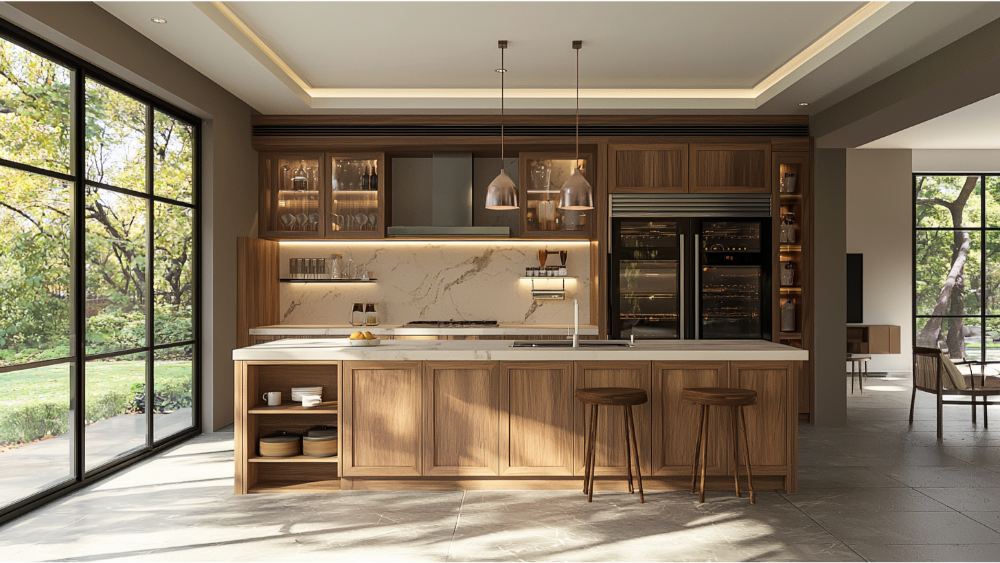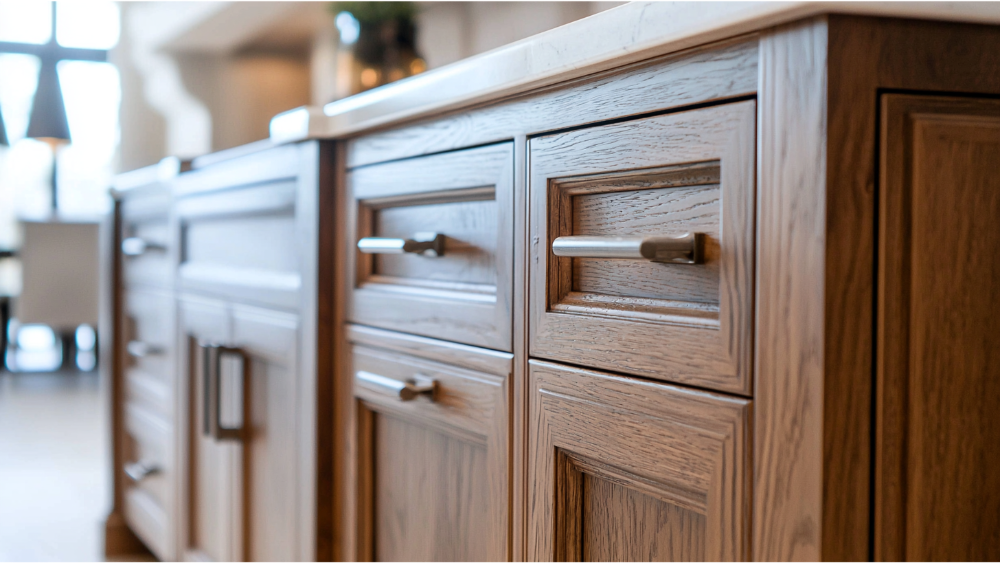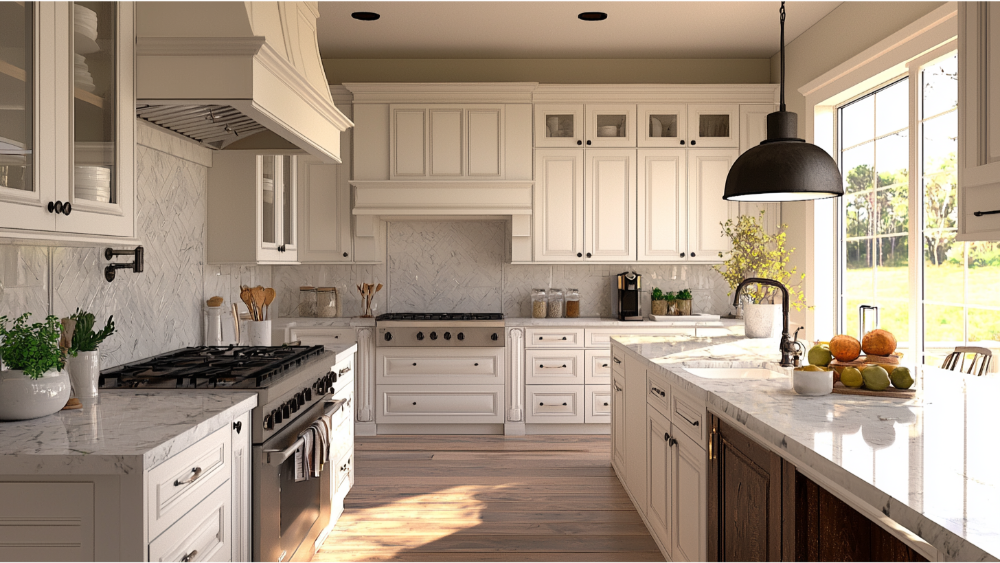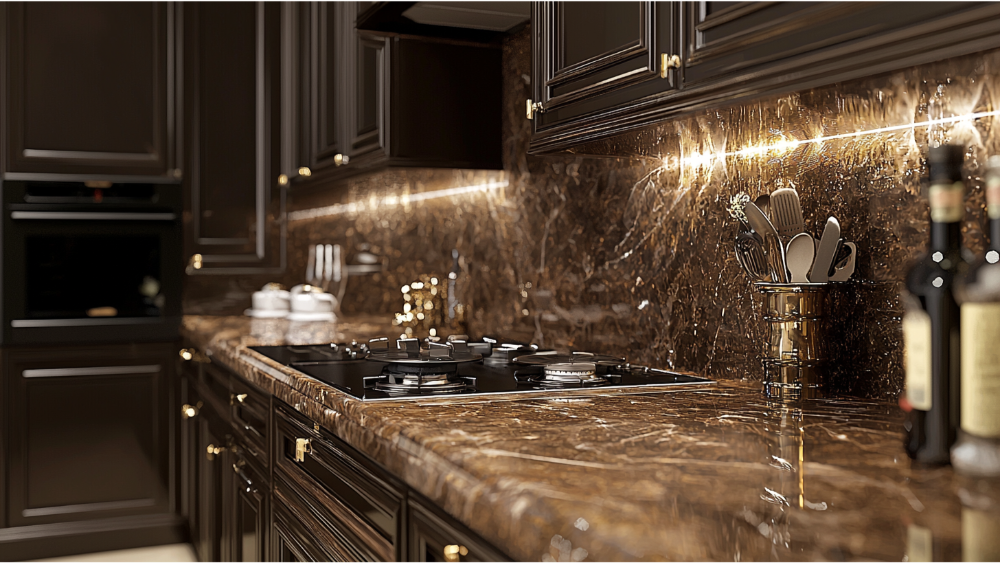
When designing or remodeling a kitchen, understanding the dimensions of kitchen cabinets is crucial for optimizing space and functionality. We will delve into the standard depths of kitchen cabinets, both base and wall-mounted, and explore how these dimensions can affect your kitchen layout.
By providing insights into typical cabinet measurements and customization options, we aim to assist you in making informed decisions that balance aesthetics with practicality in your kitchen design.
Standard Depths of Kitchen Cabinets

Base Cabinets
Base cabinets, which rest on the floor, typically have a standard kitchen cabinet depth of 24 inches. This dimension allows for ample storage space while ensuring that countertops have enough surface area for food preparation and appliances. The depth of these cabinets can sometimes be customized to accommodate unique kitchen layouts, but 24 inches remains the most common choice for functionality and aesthetics.
Upper Wall Cabinets
Upper wall cabinets are generally shallower than base cabinets, with a standard depth of 12 inches. This dimension is designed to provide adequate storage for dishes and small kitchen items while maintaining enough clearance above countertops to create an open and ergonomically friendly workspace. Adjusting the depth of these wall cabinets may be necessary for specific kitchen designs, but a 12-inch depth is typically ideal for reaching items with ease.
Tall Cabinets
Tall cabinets, also known as pantry cabinets or utility cabinets, typically have a standard kitchen cabinet depth of 12 to 24 inches. These cabinets extend from floor to ceiling and are versatile, offering extensive storage space for pantry items, brooms, or even built-in appliances. The depth of tall cabinets can vary based on individual storage needs and available kitchen space, allowing for customization to fit both form and function.
Custom and Variable Depth Options

Custom-Built Cabinets
Custom-built cabinets provide the flexibility to deviate from standard cabinet dimensions, allowing homeowners to tailor the depth to fit unique kitchen layouts or to meet specific storage requirements. By adjusting the depth beyond the standard measurements, one can maximize space utilization, ensuring that every inch of the kitchen is optimized for convenience and practicality.
For instance, deeper base cabinets can accommodate larger pots and pans, while custom shallow cabinets might be designed for smaller kitchens to maintain a spacious feel. This adaptability makes custom cabinets an excellent choice for those who have specific items to store or for kitchen designs that demand exact dimensions for harmony and efficiency. Through thoughtful customization, these cabinets can enhance both the functionality and aesthetic of any kitchen space.
Small Kitchen Solutions
In compact kitchens, shallower cabinets with depths ranging from 15 to 18 inches can be a game-changer, providing a sleek and efficient use of space. These cabinets, often used as upper cabinets or filler cabinets, help maintain an open and airy kitchen layout by reducing the optical heaviness that standard-depth cabinets might create in smaller areas.
With these shallower upper cabinets, homeowners can still enjoy ample storage for essential items like glassware, dishes, and pantry goods without sacrificing valuable surface and floor space. Likewise, filler cabinets of similar depth can be strategically placed to utilize awkward spaces or gaps, ensuring no corner goes to waste. This approach not only maximizes storage potential but also enhances the overall flow and functionality of smaller kitchens, allowing for a more enjoyable cooking and dining experience.
Extra Deep Cabinets
Opting for extra deep cabinets, such as those, can be highly advantageous for homeowners who need additional storage space for larger appliances and bulkier items. These cabinets are particularly beneficial in accommodating oversized pots, large kitchen appliances like stand mixers, or stockpots that might not fit comfortably within standard kitchen cabinet dimensions of 24 inches deep.
Double basin sinks can be effortlessly integrated into these deeper cabinets, providing a functional and stylish solution. The increased capacity allows for more organized storage, reducing clutter on countertops and making kitchen spaces appear tidier and more efficient.
In larger kitchens, 36-inch deep cabinets can be seamlessly incorporated into islands or other areas where they enhance functionality without encroaching on movement or workflow. By integrating these deep storage options thoughtfully homeowners can enjoy both a spacious feel and superb utility, striking an ideal balance in their kitchen design.
Depth Considerations for Functionality

Storage Needs
The depth of kitchen cabinets significantly influences storage capacity and the types of items that can be housed efficiently. Standard wall cabinets, with their typical 12-inch depth, are ideal for storing smaller kitchen items like glassware, plates, and pantry essentials, ensuring they are easy to reach and organize. In contrast, deeper base cabinets, usually around 24 inches deep, are better suited for larger kitchen tools such as pots, pans, and baking dishes that require more space and can be cumbersome if stored elsewhere.
Opting for even deeper cabinets, up to 36 inches, allows the accommodation of oversized appliances and bulkier items, which can help keep countertops clear and maintain the kitchen’s neat appearance. Therefore, choosing the appropriate kitchen cabinet dimensions is crucial for optimizing storage while ensuring that frequently used items are conveniently accessible.
Accessibility
When it comes to accessibility, deeper cabinets often pose a challenge, especially in terms of reaching items stored at the back. This is particularly prevalent in corner cabinets, which can create awkward spaces that are difficult to access and organize. To address this issue, incorporating pull-out shelves and organizers can be a practical solution. These features facilitate easy access by allowing users to slide the contents toward them, minimizing the need to reach far back into the depths of the cabinet.
Pull-out organizers transform hard-to-reach areas into functional spaces, ensuring that every item remains within easy reach. They can help maintain order by providing designated spots for various items, which not only improves access but also maximizes the overall storage capability of corner cabinets. By integrating these solutions, homeowners can enhance both the functionality and convenience of deeper cabinets, making their kitchen experience far more efficient and user-friendly.
Countertop Overhang Considerations
Countertop overhang is another crucial factor in kitchen design, impacting both aesthetics and functional space. Typically, countertops extend over the base cabinetry by about 1 to 1.5 inches, providing a finished look and protecting the cabinetry below. The overhang also ensures that there is ample room for preparing meals without obstructing access to drawers and doors. When designing custom cabinets, the desired countertop hang should be considered alongside the kitchen’s overall layout and flow, ensuring ease of movement and accessibility for daily tasks while harmonizing with the kitchen’s aesthetic appeal.
Frequently Asked How Deep Are Kitchen Cabinets Questions

What is the Standard Depth of a Kitchen Cabinet?
The standard depth of kitchen cabinets varies depending on their intended use. For kitchen wall cabinets, the typical depth is around 12 inches. This depth is ideal for storing smaller kitchen essentials like plates, glassware, and pantry items, providing easy access while maximizing space.
For a base cabinet, the standard depth is generally 24 inches. These cabinets are designed to accommodate larger items, such as pots, pans, and baking equipment, offering ample storage capacity while ensuring that the countertops above remain clear and organized. It’s also essential to consider standard base cabinet widths when planning the kitchen layout to optimize both functionality and accessibility.
Are All Kitchen Cabinets 24 Inches Deep?
No, not all kitchen cabinets are 24 inches deep. While 24 inches is the standard depth for base cabinets, allowing enough space for larger kitchen items and ensuring a convenient work surface on the countertop above, kitchen cabinets come in various depths to suit different purposes and layouts. Wall cabinets, for instance, are usually around 12 inches deep, making them perfect for storing smaller items such as dishes and glassware within easy reach.
Some specialty cabinets, like pantry units or extra deep base cabinets, can be up to 36 inches deep to accommodate bulkier items or oversized appliances. Custom cabinetry can also be tailored to specific dimensions, providing flexibility to meet unique space requirements and storage needs. Therefore, the depth of kitchen cabinets is varied and customizable, depending on the specific needs and design of the kitchen.
How Deep Are Custom Kitchen Cabinets?
Custom kitchen cabinets offer a great degree of flexibility in terms of depth, allowing homeowners to tailor their kitchen storage solutions to their unique needs and preferences. While standard cabinet depths serve as guidelines, custom cabinets can be designed to deviate from these norms, accommodating specific items or architectural features.
A homeowner might choose to create custom cabinets that are 30 inches deep to provide additional storage for larger appliances or cookware. Shallower custom cabinets around 15 inches deep could be utilized in narrow spaces where a conserving room is necessary. The ability to specify exact dimensions means that custom kitchen cabinets can blend seamlessly with the overall kitchen design, enhancing both functionality and aesthetics while addressing any unique constraints or requirements of the space.
Conclusion
The depth of kitchen cabinets plays a pivotal role in determining the functionality and efficiency of a kitchen space. Choosing the right cabinet depth is essential for organizing kitchen items conveniently and ensuring a seamless workflow. While standard depths of 12 inches for wall or upper kitchen cabinets and 24 inches for base cabinets provide a general guideline, there are numerous options, including custom cabinet designs, to accommodate specific storage needs and preferences. Considerations such as accessibility, the use of pull-out shelves, and appropriate countertop overhangs further enhance the practicality and aesthetic appeal of a kitchen. By carefully selecting kitchen cabinet dimensions and features, homeowners can transform their kitchen into a well-organized, user-friendly space tailored to their lifestyle.
CONTACT US
Our Services
Areas We Serve
Certificate






